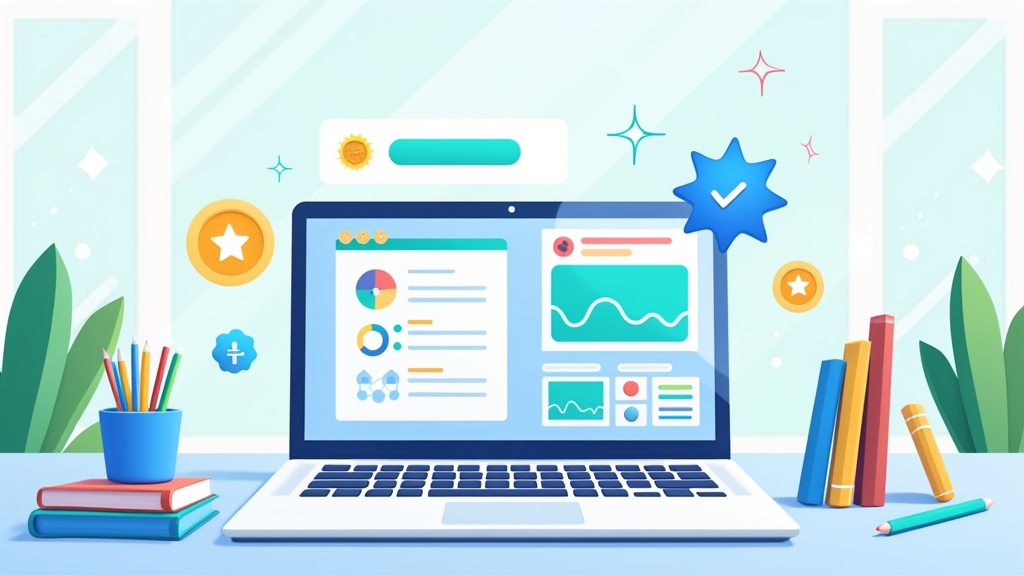advertising
How Gamification Can Transform Your Study and Remote Work
Have you ever found yourself scrolling down the screen of your phone without noticing the time passing, completely immersed in a game? Or felt that rush of excitement when you unlocked an achievement in an app? Gamification takes this same principle of engagement and applies it to real-world tasksThis makes studying and working remotely a more dynamic and motivating experience.
Imagine replacing the monotony of a spreadsheet with challenges that earn "experience points" or turning a study marathon into a mission with tangible rewards. It's not a question of infantilizing obligations, but of using playful elements to stimulate productivity and focus. After all, who doesn't like to feel like they're making progress?
advertising
In this article, we'll explore practical techniques for integrating gamification into your daily life, whether it's meeting deadlines, learning new content or maintaining discipline in the home office. Get ready to discover how badges, rankings, narratives and instant feedback can revolutionize your routine.
What Gamification Is and Why It Works
Gamification is the application of game mechanics in non-play contexts, such as education and work. It doesn't mean turning everything into a video gamebut extract elements such as rewards, healthy competition and visual progress to increase intrinsic motivation. For example, platforms such as Duolingo use streaks (sequences of consecutive days) and XP (experience points) to encourage language learning.
Why does our brain respond so well to this? The answer lies in dopamine, a neurotransmitter linked to pleasure and reward. When we complete a task and receive immediate feedback - such as a "mission accomplished" sound or a badge - our brain interprets it as a victory. This creates a positive vicious circle: the further we go, the more we want to continue.
In the remote environment, where the lack of face-to-face interaction can reduce engagement, gamification fills this gap. A study by TalentLMS showed that 83% of employees feel more motivated after gamified experiences. And for students, the technique can reduce procrastination, as research into active learning methodologies has shown.
But beware: gamification is not just about collecting points. To work, it needs to have clear objectives, achievable challenges and significant rewards. If the "prizes" are irrelevant or the challenges impossible, the effect can be the opposite: frustration and giving up.
Essential Elements for Gamifying Your Routine
Do you want to start applying gamification? Then you need to know the pillars that support this strategy. Clear goals are the first step: instead of "study math", define "solve 20 algebra exercises to unlock the next level". Tools such as Trello allow you to create boards with to-do lists that become "missions", while apps like Habitica turn habits into an RPG where you evolve your character.
Another crucial element is immediate feedback. In games, you know exactly how many points are left to level up or how much time is left to complete a stage. At work or study, you can simulate this with Pomodoro timers (25 minutes of focus followed by 5 minutes of break) or with spreadsheets that calculate your daily progress. Visualizing progress, however small, keeps the flame of motivation burning.
Don't underestimate the power of rewards. They don't have to be material - they can be a break to watch an episode of a series after finishing a report or a "virtual trophy" for meeting a week's targets. For remote teams, leaders can create monthly rankings (with symbolic rewards, such as choosing the next meeting agenda) or "coins" exchangeable for days off.
Finally narrative gives meaning to tasks. Instead of "making sales calls", imagine that you are an explorer uncovering new territories (customers). Students can create a "knowledge map" where each chapter learned is an island discovered. This layer of storytelling makes the process memorable and fun.
Tools and applications to put into practice
The theory is fascinating, but how do you take it into the real world? Fortunately, there are dozens of tools designed to gamify productivity. For individual tasks, o Forest combines focus with social impact: every time you don't use your cell phone, a virtual tree grows - and in the premium version, real trees are planted. The FocusMate connects you to an accountability partner via video, simulating a "mission companion".
In remote teamsplatforms such as Slack integrate gamification bots (such as HeyTaco!) that allow colleagues to send recognition tokens. By accumulating these tokens, they can be exchanged for benefits such as flexible working hours. To manage projects, the Asana lets you create to-do lists with progress bars and animated celebrations when you mark items as completed.
Students can explore Quizlet, which turns flashcards into competitive games, or the Khan Academywhere you gain energy from watching videos and solving exercises. The key is to choose tools that are aligned with your objective: if your goal is to read more, apps like Goodreads challenge users to meet annual targets with progress updates.
What if you prefer offline solutions? Create an "achievement board" at home with colored post-its: each task completed becomes a sticker, and by forming a sequence, you reward yourself with something special. The important thing is that the system is visual and tactile - remember that physical games, such as boards, also generate engagement.
How to Avoid Common Pitfalls in Gamification
Gamification is powerful, but it can have negative effects when applied incorrectly. A frequent mistake is prioritize quantity over quality. If a salesperson is rewarded only for the number of calls (and not for conversion), they may neglect the customer experience. In education, students can "chase points" by memorizing answers without really learning. Therefore, always align rewards with deep objectives.
Another risk is excessive competition. Rankings can motivate some, but discourage those at the bottom. To avoid this, balance competition with collaboration: create "group missions" where everyone contributes to a common goal (such as collecting X hours of collective training). In virtual classrooms, teachers can divide classes into guilds that earn points for participation.

You also need avoid saturation. Rewards lose their luster if they're too easy or too frequent. Vary the types of challenges and introduce surprise elements - such as "bonus missions" that appear at random. Tools such as Beeminder even use real consequences (such as financial charges) for those who deviate from their goals, increasing commitment.
Finally, listen to feedback from participants. If your team thinks the badges are childish or a student feels the levels are unfair, adjust the system. Gamification must be inclusive and adaptable. After all, there's no such thing as a fun game without satisfied players.
Real Cases: Who Has Used Gamification and How It Worked
Need some inspiration? The giant Microsoft created "Ribbon Hero", a game that taught users how to use Office while competing for points. The result: 70% of the participants improved their skills in less than an hour. The Deloitte gamified its training program, reducing course completion time by 50%.
In education, the Brazilian teacher Ana Paula Gaspar used a system of "missions" to teach history: students became spies who unraveled the mysteries of Ancient Egypt. Class grades rose 30%, and absenteeism fell. Another example is Classcraft, a platform that turns lessons into medieval adventures - schools report a 90% increase in engagement.
In remote work, the startup Automattic (creator of WordPress) holds monthly hackathons where employees form teams to create projects in 24 hours. The winners get grants to implement their ideas. And Zappos uses a "value in action" system, where employees exchange virtual coins for experiences, such as lunch with the CEO.
What do these cases have in common? They all started from real problems (boredom in training, lack of remote interaction) and used creativity to make everyday activities extraordinary. You don't need a million-dollar budget - just a bit of daring.
Adapting Gamification to Your Psychological Profile
Not everyone is motivated in the same way. According to the theory of Andrzej MarczewskiThere are four player profiles: Socializers (who seek interaction), Conquerors (focused on mastering challenges), Explorers (who love to discover new things) and Assassins (competitive). Identifying your type helps personalize gamification.
If you are a Socializer, apps such as Discord or study groups with collective goals will be more effective. Conquerors can benefit from level systems with hard-to-reach badges (such as "productivity master" after 100 flawless tasks). Explorers will love platforms like MemriseThe other two, which reveal cultural curiosities as they progress through the languages. Now Assassins can compete in rankings on Codecademy or in sales challenges.
What if you don't fit in with any of them? Create a hybrid system. For example: study for 25 minutes (Pomodoro technique for Conquerors), then share your progress in a forum (for Socializers) and explore a random topic for 10 minutes (for Explorers). Self-knowledge is the key to sustaining gamification in the long term.
Take the First Step: An Action Plan in 7 Days
Ready to get started? Follow this adaptable roadmap:
Day 1: Define your main objective. Do you want to read more books? Deliver projects on time? Learn Excel? Write it down on a piece of paper and divide it into microtasks (e.g. "read 10 pages a day").
Day 2: Choose a gamification element. It can be points (1 point per task), streaks (like Duolingo) or a level system (10 tasks = level 1). Use an app or a simple spreadsheet.
Day 3: Establish rewards. For each level achieved, watch an episode of your favorite series. If you work in a team, arrange for the leader of the ranking to choose the music for the next meeting.
Day 4: Add unforeseen events. Create 2-3 "bonus cards" (e.g. "XP doubler: complete 2 tasks in 30 minutes"). This maintains the surprise factor.
Day 5: Invite other people. Share your progress with a friend or create a WhatsApp group to post achievements. Positive social pressure increases adherence.
Day 6: Adjust the rules. Do you realize that collecting 100 points is too easy? Increase the challenge. The system should evolve with you.
Day 7: Celebrate! Reflect on what worked and what could be improved. Gamification is an ongoing experiment - and the biggest prize is productivity without suffering.
So, which mission will you accept today? Remember: even the most complex games start with a first move. Grab your controller (or your spreadsheet) and start playing - the next level of your potential is waiting.


